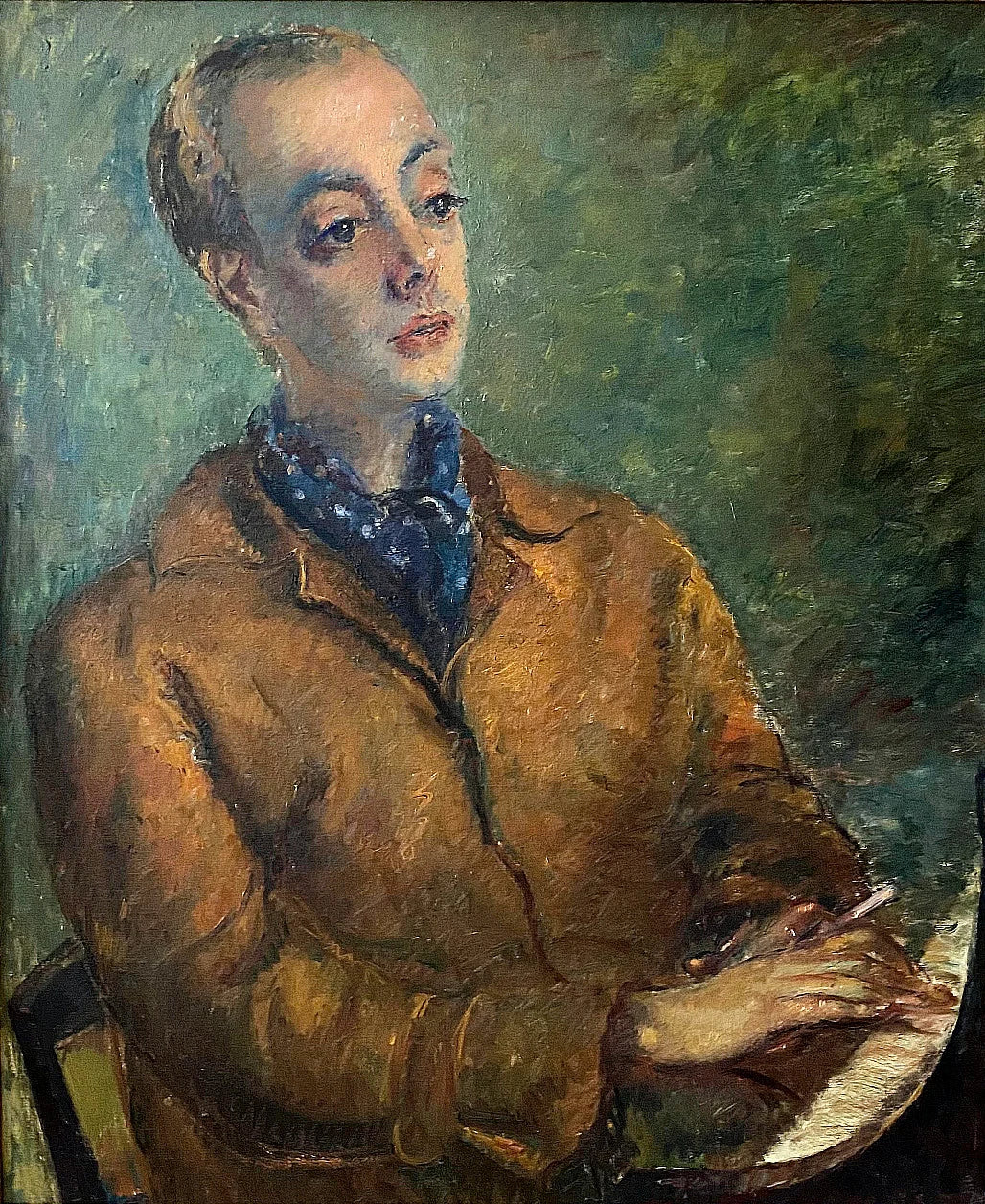

Clara Klinghoffer
Portrait of Stanley Bate
Oil on canvas
Image size: 24 x 29 inches (61 x 73.5 cm)
Contemporary style gilt frame (Image below)
Provenance
From the estate of the artist, Clara Klinghoffer
This portrait is by an artist who propelled rapidly into the limelight after her first solo exhibition in 1920, at the age of 19, with the Daily Graphic naming her as the ‘Girl Who Draws Like Raphael’. Yet today Clara Klinghoffer’s name is little know.
Klinghoffer’s early success resulted in numerous portrait commissions, including this one of the English composer Stanley Bate. The bold use of colour and naive execution of this portrait clearly reveals the modernist influence of fellow Jewish artists such as Bernard Meninsky, Jacob Kramer and Mark Gertler. Bate is seen in a natural pose, cigarette in hand while he sits at his piano. The delicate brushstrokes that make up the subject and background are typical of Klinghoffer’s style and demonstrate her noted sensitivity and skill as a portraitist.
Stanley Bate
A cursory glance at the limited information on Stanley Bate will bring up luminaries of the musical world including the famed teacher Nadia Boulanger, composer Ralph Vaughan Williams, music critic and composer Virgil Thomson, and the list goes on and on. Although he was older than Benjamin Britten, Bate began his studies at the Royal College of Music after Britten, with Vaughan Williams, Arthur Benjamin, Gordon Jacob and R.O. Morris as his teachers.
After a period in Paris with Boulanger, a spell in Berlin with Hindemith, and before World War Two, Bate had a highly successful career – particularly as a composer of ballet, collaborating with the likes of Marie Rambert and Ninette de Valois.
Yet all of this was to change, and with the onset of war he moved with his wife, the composer Peggy Glanville Hicks, to Australia and then on to the USA. Although there were more successes to come, with music performed at Carnegie Hall, and then once back in the UK eventual broadcasts on the BBC, Bate’s career was never to regain its pre-war position.
There were further complications to his story as well, personal ones, including a breakdown and periods of depression, alcoholism, and also issues around his sexuality. Then came his early death.
This is the only known portrait of Mr Bate.
Clara Klinghoffer
Painter Clara (née Chaje Esther) Klinghoffer was born into a Jewish family in Szerzezec (now Lemberg), a village near Lwów (now Lviv), in Polish Galicia, then in the Austro-Hungarian Empire (now Ukraine) in 1900. She moved to England with her family at the age of three, settling first in Manchester, before moving to London’s East End. She drew from a young age, briefly taking classes at the John Cass Institute in Aldgate in 1914, before moving to the Central School of Arts and Crafts under Duncan Grant and Bernard Meninsky (1915-18), where she quickly established a reputation as the new ‘girl genius’, then completed her studies at the Slade School of Fine Art (1918-20).
While still a student, she held her first exhibition at the Hampstead Art Gallery in 1920. Further solo exhibitions followed at the Leicester Galleries, London (1923, 1932), the Redfern Gallery, London (1926, 1929, 1938) and Godfrey Phillips Galleries, London (1929); she also exhibited with the Goupil Gallery salons – where her drawings, including many studies of women (often based on her six sisters) and children, were frequently likened to Raphael – the New English Art Club, the London Group, the Women’s International Club, the Royal Academy and the Carnegie International.
In 1923 and 1927 her work was included in two prestigious exhibitions of ‘Jewish art’ (although she disliked this label) at the Whitechapel Art Gallery, and at Ben Uri Gallery in 1935 – her painting ‘The Girl in the Green Sari’ was acquired for the collection the same year (the first accessioned work by a female artist).
In 1926 she married Dutch journalist Joop Stoppelman and moved with him to Paris in 1928. Following her solo exhibition in Amsterdam in 1928, they moved to Holland with their children in 1930. In 1939, aware of the imminent threat of German invasion, the family moved again, this time to America and Klinghoffer subsequently split her life between London and New York, where she held solo exhibitions in 1941, 1951, 1958 and 1958.
In her later years, however, her work suffered from the decline in demand for figurative painting; her final solo show was in Mexico City in 1969. Clara Klinghoffer died in London, England in 1970. A private exhibition was held in London in 1972, with further retrospectives at the Belgrave Gallery, London in 1976 and Bowes Museum, Barnard Castle in 1977.
Klinghoffer’s work is represented in many UK collections including Aberdeen Art Gallery, the Fitzwilliam Museum, the National Portrait Gallery and Tate.



